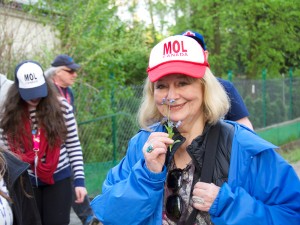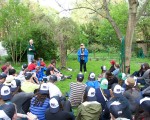Teens on this year’s March of the Living helped Lillian Boraks-Nemetz face down haunting memories. (photo by Adele Lewin Photography)
Lillian Boraks-Nemetz, a Vancouver poet and author who was a child survivor of the Holocaust, initially declined the offer of a trip to her Polish homeland. She had been there, and written books and poems about her experiences as a child and as a returning adult. She didn’t know that an invitation to go again would lead to an emotional and psychological closure for which she had waited seven decades.
When first invited to participate in last spring’s Canadian contingent of March of the Living, Boraks-Nemetz demurred. March of the Living is a program that brings Jewish young people from around the world to the sites of Nazi atrocities in Europe and then to the Jewish homeland of Israel, marching from Auschwitz to Birkenau on Yom Hashoah, Holocaust memorial day, and traveling to Israel in time for Yom Hazikaron, Israel’s remembrance day for fallen soldiers, and Yom Ha’atzmaut, Israeli independence day. March of the Living’s teenage participants are accompanied by Holocaust survivors.
“I thought, how am I going to keep up with a bunch of 16-, 17-year-olds?” Boraks-Nemetz said in a recent interview. But she was assured that survivors are well taken care of on the trips and she was convinced to go.
“There were difficulties, but I rose to the occasion,” she said, laughing. On the extremely long day traveling from Canada to Poland, which then continued immediately with more travel and programming, Boraks-Nemetz was aided by one of the young participants. “One of the girls had chocolate that had extra caffeine in it, so she gave it to me,” she explained.
Boraks-Nemetz was accompanied by another survivor, chaperones and young people from Edmonton, Calgary, Winnipeg and Ottawa, as well as eight Jewish teens from Vancouver. In all, there were 78 people on the trip. (Young people from Ontario and Quebec made up their own contingents and traveled on different buses.)
The program was intensive. The week in Poland involved stays in Krakow and Warsaw, where they visited the Museum of Polish Jews, and they went to the extermination camps Auschwitz-Birkenau and Majdanek.
“The young people who came with us are so beautiful and so good and so well behaved and so moved by everything. You could just see how they took it all in. For them, it was a life-changing experience.”
“The young people who came with us are so beautiful and so good and so well behaved and so moved by everything,” she said. “You could just see how they took it all in. For them, it was a life-changing experience.”
In Warsaw, they also went to the orphanage that had been run by Janusz Korczak. A Polish Jew who was a respected published author, Korczak was offered multiple opportunities to save himself from the advancing Final Solution. When the Warsaw Ghetto was created, Korczak’s orphanage, its staff and nearly 200 young charges were forced to move into the ghetto. When the ghetto was liquidated, in 1942, Korczak was again offered immunity, but instead stayed with his orphaned children as they were deported to Treblinka.
In Lodz, the group visited the cemetery and the place where the second-largest Nazi-enforced Jewish ghetto had been. (More than 200,000 Jews were held in Lodz Ghetto during its existence. About 10,000 of those were alive in 1945.) There, the Canadians boarded one of the rail cars that had transported Jews to the camps.
“It was dark and there were many of us,” said Boraks-Nemetz. “It was tight. It was scary. We got the feel of it. Of course, the fear wasn’t there, but there was something foreboding about it.”
At the camps, the participants said prayers and sang mournful songs.
“There was a lot of poetry,” she said. “I brought my book Ghost Children, which was written after one of my trips there. And, whenever we went to a certain place, I would read a poem and it really got to them.”
An unexpected insight came during conversations with young Polish Jews during an arranged dinner at the hotel in Warsaw.
“They sat down, one at each table of students, so they were able to talk,” said Boraks-Nemetz. “At the end of the dinner, I saw the five or six of them standing in the lobby of the hotel, the Polish Jews, and so I went to talk to them. We went to the side and it was really interesting what they told me. They’re quite modern. They’re a little bit shy. They’re a big change from the Israeli youth,” she said, laughing.
The young Polish Jews told her that things were pretty good for them. Some go abroad – to France or elsewhere – to study, but jobs are hard to find and the standard of living isn’t great. They had a question about March of the Living.
“They said, ‘Why do you always come here looking for what’s dead?’ And I explained to them that this is an educational trip,” said Boraks-Nemetz. “But they said, ‘You know, there are some of us here, there is beauty here too, we are alive and there is a Jewish community – small, but there is a Jewish community. And I could see that that was maybe something to address.”
From Poland, the group flew El-Al to Israel.
“It’s like walking in from the shadow into light,” she said. “The Jerusalem of Gold! And we went straight to Masada off the plane.”
There, the other survivor on the trip, Max Iland, an octogenarian from Sault Ste. Marie, Ont., celebrated his bar mitzvah, a few decades late.
“The students were singing and he and I were dancing, it was really fantastic,” said Boraks-Nemetz.
The entire experience, she said, was life-altering for the participants.
“They felt that their Jewishness was strengthened, that they are a part of history,” she said. “They cherish their homes and their families after finding out what happened to Jews over there. And, above all … they were becoming witnesses to my story. That’s what one of them said. She felt she was a witness to it. I did speak to them about the legacy that we, survivors who were on our way out, are leaving them.”
Boraks-Nemetz found especially notable the connection of young Canadian Jews to those who had given their lives in defence of the Jewish state.
“What I didn’t realize was how strongly they feel about the fallen soldiers who fought for Israel,” she said. “They read poetry again to the fallen soldiers.”
When the national moment of silence came, the experience was transfixing.
“We’re standing on [Tel Aviv’s central street] Ben Yehuda and the sirens sounded and, all of a sudden, it was like everyone was made of wax figures. That was an incredible thing.”
For Boraks-Nemetz, the trip provided an unexpected closure to the darkest chapter of her life.

For her, the climactic moments of the March of the Living took place in the small Polish village of Zalesie. It was here that young Lillian survived the Holocaust in hiding. After spending two years in the Warsaw Ghetto, she was smuggled out by her father before the ghetto was liquidated and its residents – more than a quarter million Jews – were sent to Treblinka and other death camps. Outside the ghetto, she was met by a Christian woman who transported her to a little white home in Zalesie, where her grandmother was in hiding, posing as the wife of the Polish man who lived there.
Boraks-Nemetz has written about that time in her poetry and in her book for young adults, The Old Brown Suitcase. As an adult, she has returned to the little house at Spokojna Street, Number 16. But this visit was different.
“These two buses went down this dusty road, and there were all these [people in] houses wondering what was going on,” she said. “Nobody bothered us. We filed out and we went into the garden. We all stood in the garden and I told them the story of hiding.”
There was one part of the story she hadn’t intended to tell, but she had developed closeness and trust with the participants accompanying her. She felt confident and compelled to share more than she ever had before, which led to an unprecedented emotional catharsis after almost seven decades.
“I told them something about the man with whom we were in hiding. He was both good and bad,” Boraks-Nemetz said. “How does a child of eight take that? That, on the one hand, he saved us, our lives, and, on the other hand, he was a drunk who could have given us away and didn’t, and, thirdly, he abused me when my grandmother wasn’t there. This is life and that’s how it was.”
In small groups of six or eight, the young people accompanied Boraks-Nemetz into the home.
“When we went into the house, I explained where I slept and where I stood by the window and watched for my parents to come, the road, the garden, the whole thing,” she said. “They were very moved, and a funny thing happened. Each time a group would come out, I would come out with them onto the little porch and they would all hug me. Every one of them. And I think what happened to me was probably, for the first time in my life, I was able to face what happened there. That was an awesome experience for me. I had been there before many times but I always blocked it out. I never faced it properly. And, this time, because of the kids … I just couldn’t believe how it opened me up, this experience with the kids.”
Pat Johnson is a Vancouver writer and principal in PRsuasiveMedia.com.

